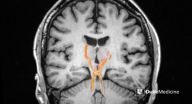(Press-News.org) This news release is available in German.
Scientists at the German Center for Neurodegenerative Diseases (DZNE) and the University of Bonn led by Prof. Stefan Remy report on this in the journal "Neuron". Their investigations give new insights into the workings of spatial memory. Furthermore, they could also help improve our understanding of movement related symptoms associated with Parkinson's disease.
In a familiar environment our movements are purposeful. For example, if we leave our office desk for a coffee break, we naturally follow a predefined route that has been stored in our memory: Through the office door, left into the hall, past the windows. To keep us on track, our brain has to process varying sensory impressions quickly. "This is a fundamental issue our brain has to deal with. Not just on our way to the coffee machine, but any time we move in space. For example when we are on a bike or in a car," explains Remy. With increasing speed, the data rate also increases, he emphasizes: "The faster we move, the less time the brain has to take in environmental cues and to associate them with a location on our memorized spatial map. Our perception therefore has to keep pace with the speed of movement so that we remember the right way to go. Otherwise we end up at the copy machine instead of the coffee machine."
Rhythmic fluctuations
It has been known for some time that the hippocampus - the part of the brain that controls memory, particularly spatial memory - adjusts to the speed of locomotion. "The electrical activity of the hippocampus undergoes rhythmic fluctuations. The faster we move, the faster certain nerve cells are activated," says Remy. "This increased activation rate sensitizes the brain. It becomes more receptive to the changing sensory impressions that have to be processed when moving."
But how does the brain actually know how fast a movement is? Previously there was no answer to this question. Now, Remy and his colleagues have decoded the mechanism. For this, they stimulated specific areas within the mouse brain and recorded the ensuing brain activity and the mice's locomotion. "We have identified the neural circuits in mice that link their spatial memory to the speed of their movement. This interplay is an important foundation for a functioning spatial memory," says Remy. "We assume that humans have similar nerve cells, as the brains of mice and humans have a very similar structure in these regions."
Small cell group
The cells in question are located in the "medial septum", a part of the brain directly connected to the hippocampus. They make up a relatively small group comprising a few thousand cells. "They gather information from sensory and locomotor systems, determine the speed of movement and transmit this information to the hippocampus. In this way, they tune the spatial memory systems for optimized processing of sensory stimuli during locomotion," explains Remy. However, these circuits have even more functions. "We have found that they also give the start signal for locomotion and that they actively control its speed. Until now, this control function was almost exclusively ascribed to the motor cerebral cortex."
These newly discovered nerve cells are linked with areas of the brain that are affected by Parkinson's in humans. This disease is associated with movement-related symptoms and can cause dementia. "In this respect, our results go beyond the workings of spatial memory; they also have the potential to provide new insights into how memory systems and the execution of movements are affected in Parkinson's disease," says Remy.
INFORMATION:
Original publication
„Locomotion, Theta Oscillations, and the Speed-Correlated Firing of Hippocampal Neurons Are Controlled by a Medial Septal Glutamatergic Circuit", Falko Fuhrmann, Daniel Justus, Liudmila Sosulina, Hiroshi Kaneko,Tatjana Beutel, Detlef Friedrichs, Susanne Schoch, Martin Karl Schwarz, Martin Fuhrmann, Stefan Remy, Neuron 2015, doi: 10.1016/j.neuron.2015.05.001
Video-Abstract
https://www.youtube.com/watch?v=Q8BGehgXK94
The German Center for Neurodegenerative Diseases (DZNE) investigates the causes of diseases of the nervous system and develops strategies for prevention, treatment and care. It is an institution of the Helmholtz Association of German Research Centres with sites in Berlin, Bonn, Dresden, Göttingen, Magdeburg, Munich, Rostock/Greifswald, Tübingen and Witten. The DZNE cooperates closely with universities, their clinics and other research facilities.
http://www.dzne.de
http://www.twitter.com/dzne_en
http://www.dzne.de/facebook
This news release is available in German.
Contaminated samples have evidently created some confusion in the timetable of life. On the basis of ultra-clean analyses, an international team, including scientists from the Max Planck Institute for Biogeochemistry, has disproved supposed evidence that eukaryotes originated 2.5 to 2.8 billion years ago. In contrast to prokaryotes such as bacteria, eukaryotes have a nucleus. Some researchers thought they had discovered molecular remnants of living organisms in rock samples up to 2.8 billion years old. However, as the ...
A team of New York University neuroscientists has determined how a pair of growth factor molecules contributes to long-term memory formation, a finding that appears in the journal Neuron.
"These results give us a better understanding of memory's architecture and, specifically, how molecules act as a network in creating long-term memories," explains the paper's senior author, Thomas Carew, a professor in NYU's Center for Neural Science and dean of NYU's Faculty of Arts and Science. "More importantly, this marks another step toward elucidating the intricacies of memory ...
DURHAM, N.C. - Scientists at Duke Medicine have produced a 3-D map of the human brain stem at an unprecedented level of detail using MRI technology.
In a study to be published June 3 in Human Brain Mapping, the researchers unveil an ultra high-resolution brain stem model that could better guide brain surgeons treating conditions such as tremors and Parkinson's disease with deep brain stimulation (DBS).
The new 3-D model could eliminate risky trial-and-error as surgeons implant electrodes -- a change akin to trading an outdated paper road atlas for a real-time GPS.
"On ...
An international team of scientists led by Cardiff University researchers has provided the strongest evidence yet of what causes schizophrenia - a condition that affects around 1% of the global population.
Published today (17:00BST, 03/06/2015) in the journal Neuron, their work presents strong evidence that disruption of a delicate chemical balance in the brain is heavily implicated in the disorder.
In the largest ever study of its kind, the team found that disease-linked mutations disrupt specific sets of genes contributing to excitatory and inhibitory signalling, ...
A large majority of Americans--including gun owners--continue to support stronger policies to prevent gun violence than are present in current federal and most state law, according to a new national public opinion survey conducted by researchers with the Johns Hopkins Center for Gun Policy and Research at the Bloomberg School of Public Health.
The survey is a follow-up to one conducted by the same researchers in early 2013, shortly after the shooting at the Sandy Hook Elementary School in Newtown, Connecticut that left 26 dead.
The results are published online in Preventive ...
This news release is available in French. Professors Frederick Gosselin and Daniel Therriault, along with their master's student Renaud Passieux, are not related to Spiderman. Nevertheless, these Polytechnique Montreal researchers have produced an ultra-tough polymer fibre directly inspired by spider silk! They recently published an article about the project in the journal Advanced Materials.
Spider silk: a thread with stunning properties
Three to eight microns in diameter but five to ten times tougher than steel or Kevlar: despite its lightness, spider silk has ...
Love the opera? Hungry for hip hop? It turns out that your musical likes and dislikes may say more about you than you think, according to UBC research.
Even in 2015, social class continues to inform our cultural attitudes and the way we listen to music, according to the study, which was recently published in the Canadian Review of Sociology.
"Breadth of taste is not linked to class. But class filters into specific likes and dislikes," said Gerry Veenstra, study author and professor at UBC's Department of Sociology.
The study involved nearly 1,600 telephone interviews ...
A NASA-generated animation of NOAA's GOES-West satellite imagery from June 1 to 3 showed Hurricane Andres' eye disappear as the storm weakened into a tropical storm.
NOAA's GOES-West satellite has provided continuous visible and infrared imagery of the former hurricane since it was born. An animation created by the NASA/NOAA GOES Project at NASA's Goddard Space Flight Center in Greenbelt, Maryland captured the storm as it made the transition from a hurricane, back into a tropical storm. Andres is located in the Eastern Pacific Ocean, south of Baja California, Mexico. ...
Alcohol use disorder as defined by a new diagnostic classification was widespread and often untreated in the United States, with a lifetime prevalence of 29.1 percent but only 19.8 percent of adults were ever treated, according to an article published online by JAMA Psychiatry.
Alcohol use disorders are among the most prevalent mental health disorders worldwide, resulting in disability and contributing to illness and death. Because of the seriousness of alcohol use disorders, updated epidemiologic data are needed given the changes to the alcohol use disorder diagnostic ...
Tropical Storm Blanca strengthened into a hurricane while remaining almost stationary and about 400 miles west of the west coast of Mexico on June 3. NASA's Terra satellite captured an image of Blanca before it strengthened, while NOAA's GOES-West satellite saw the strengthening storm develop a pinhole eye.
Satellite data indicate that Blanca continues to rapidly strengthen as a small eye has become apparent in infrared imagery from NOAA's GOES-West satellite during the early morning hours today, June 3.
Blanca hasn't moved much in the last day but has continued to ...



